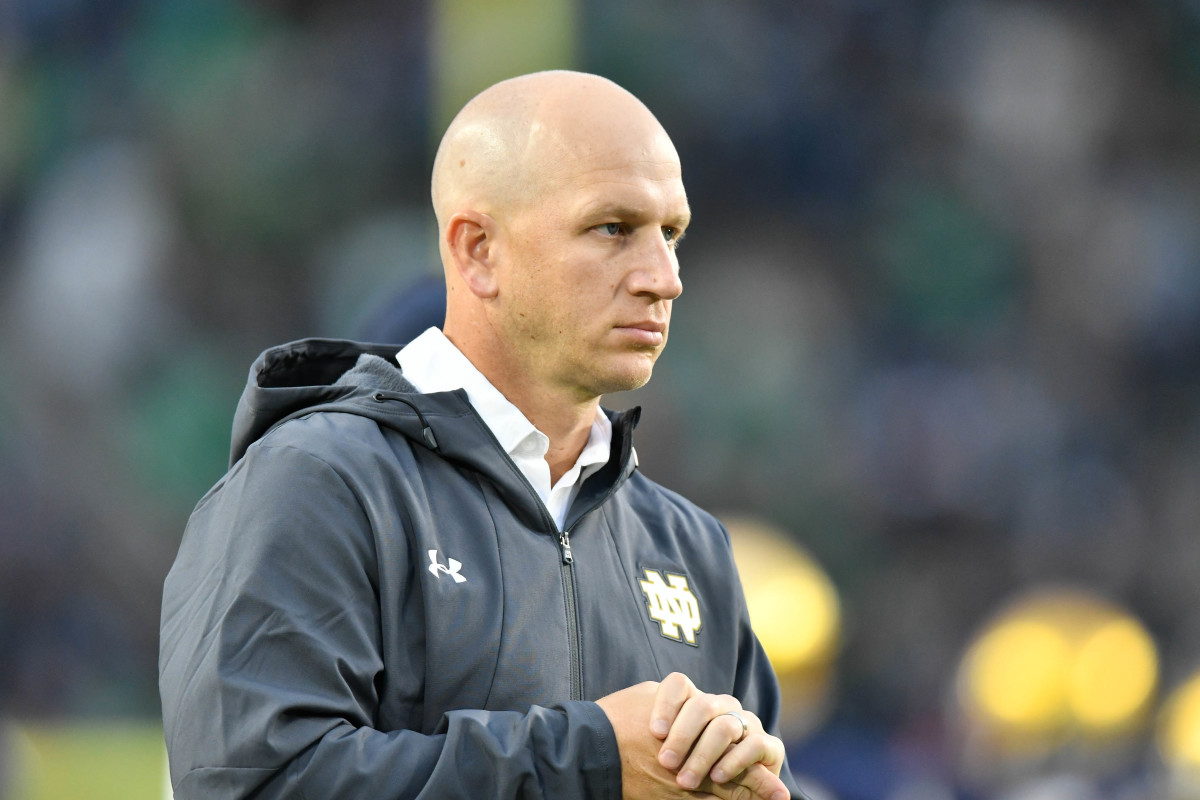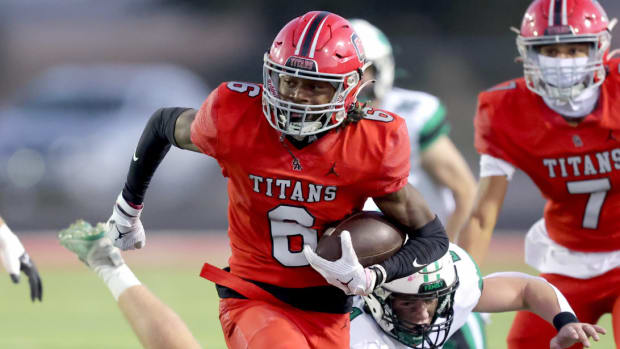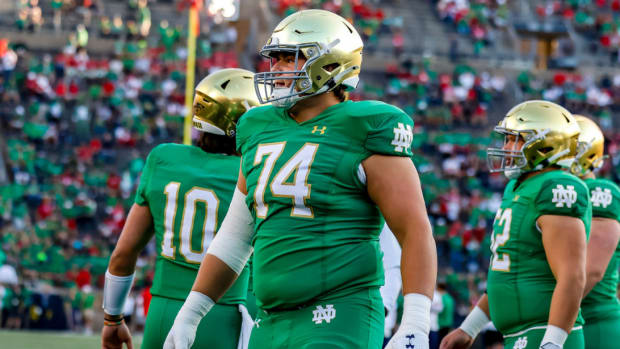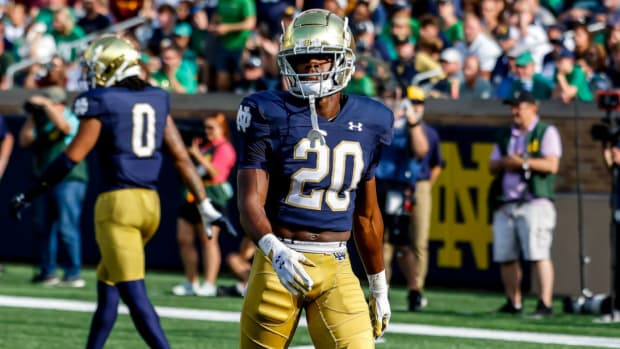Notre Dame Defense Is On The Verge Of Elite Status

When former defensive coordinator Mike Elko and current defensive coordinator Clark Lea arrived at Notre Dame following the 2016 season, they were tasked with rebuilding a Notre Dame defense that was coming off arguably its worst three-year stretch in school history.
Year one saw a big jump forward, which resulted in Elko getting a huge pay bump to take over the Texas A&M defense. Lea was elevated from linebackers coach to coordinator following the 2017 season, and over the last two years Lea has completely changed the face of the Irish defense.
Lea has quickly established himself as one of the best teachers and coordinators in the business. Notre Dame needs to take the advice of Teddy KGB from Rounders and “Pay that man his money.”
Notre Dame needs to be proactive and lock Lea up with the kind of salary bump that will make it very hard for him to leave South Bend anytime in the near future.
Let’s take a look at how Lea’s defense stacks up against other defenses in the Kelly era.
PPG stands for points per game, YPG stands for yards allowed per game, YPP stands for yards allowed per play, Rush YPG stands for rushing yards allowed per game, 3.89 stands for yards allowed per rush attempt.
While the Notre Dame defense as a whole is not yet on the elite level, the pass defense has been.
YPG stands for passing yards per game, YPA stands for yards allowed per pass attempt, YPC stands for yards allowed per completion, Comp.% stands for the opposition completion percentage, rating stands for opposing quarterbacks passer ratings.
Notre Dame has allowed fewer than 20 points per game in a season just three times in head coach Brian Kelly’s ten seasons in South Bend, and two of them have been over the last two years. What’s even more impressive about Notre Dame’s 2019 results is the fact the Irish played five Top 30 offenses according to the Fremeau Efficiency Index, and Boston College ranked 35th.
The FEI and the ESPN Football Power Index ranked the Notre Dame defense seventh in the nation, which is the second best mark of the Kelly tenure. Only the 2012 defense was better.
Notre Dame ranked 17th nationally in scoring defense, 22nd in total defense, 11th in yards allowed per play, seventh in pass efficiency defense, fourth in turnovers gained and 21st in tackles for loss. There were only five Power 5 defenses to rank in the Top 25 in each of those categories: Notre Dame, Clemson, Ohio State, Oregon and Auburn.
What makes the improvements under Lea so impressive is just how bad the Irish were on defense from 2014 to 2016. Twice during that tenure the Irish gave up at least 27.8 points per game, and in 2015 the defense gave up 24.1 points per game despite having Jaylon Smith, Sheldon Day, Romeo Okwara, Isaac Rochell, Jerry Tillery, KeiVarae Russell, Elijah Shumate, Max Redfield, Cole Luke and Matthias Farley in the lineup.
All four of Notre Dame’s starting defensive linemen from that season are now playing in the NFL and the Irish had the Butkus Award winner (Smith) playing linebacker, yet that defense didn’t come close to the production we saw from either of Lea’s last two defenses.
Notre Dame lost three All-Americans from its 2018 defense, and also lost captain and fourth round NFL Draft pick Drue Tranquill at linebacker. Despite those losses, and an early season injury to standout end Daelin Hayes, the Irish defense still allowed fewer yards and fewer yards per play despite playing a much tougher schedule than it did in 2018. The scoring average is just 0.5 behind last season’s average against a schedule full of better offenses.
After losing standout Julian Okwara in the 38-7 win over Duke, Notre Dame held its next three opponents to an average of 17.0 points per game, and two of the touchdowns it allowed were in late game situations against the backup defense.
Lea’s defense has been a bit different the last two seasons, which is further evidence of how effective he is leading that group. He had to adjust how his defense was structured to fit a different skill set among his roster.
That is the mark of a good football coach.
ROOM FOR IMPROVEMENT
Although Lea has done a tremendous job building the defense the last two seasons, there is still room for improvement. There is another level to get to from a scoring defense standpoint. Notre Dame ranked 17th in scoring defense at 18.7 points per game. Ohio State, Clemson, Georgia and Utah — four teams contending for a College Football Playoff berth — are all giving up 11.8 points or less.
Notre Dame can match those teams in disruption numbers, but the difference between the Irish and those squads is run defense. The Irish facing Navy every year will always skew their run numbers a bit, but even if the Navy game is removed the run defense allowed 149.6 yards per game. The four teams discussed above are all holding opponents to 106.3 rushing yards or less.
Notre Dame does not need to get to that level, and the nature of how the Irish schedule will also inflate their numbers (in a way that hinders their raw numbers rankings), but getting the run game numbers below about 120 yards would be the next step I’d like to see for the defense.
But we must remember that Notre Dame is just three years removed from the worst three-year stretch of run defense in school history. The progress has been enormous, even though more is needed.
And while stopping the run and running the ball are still vitally important to competing for and winning championships, modern football has evolved and the pass game is a much greater part of team’s success. Lea has built Notre Dame into one of the truly elite pass defenses in the country. If he can maintain that while also continuing to improve the run defense the Irish will then jump into that elite status.
In the coming weeks I will address some recruiting areas that will help the Irish get to that elite status, but in many ways the coaching is already there is the talent is very, very close, especially along the front seven.
Follow me on Twitter: @CoachD178
Visit our Facebook page at: https://www.facebook.com/IrishMaven/







